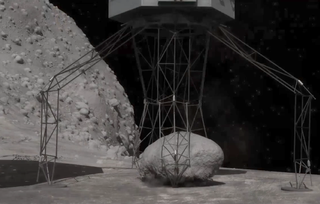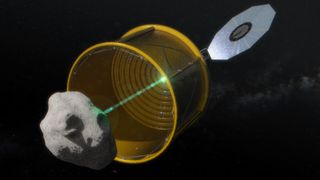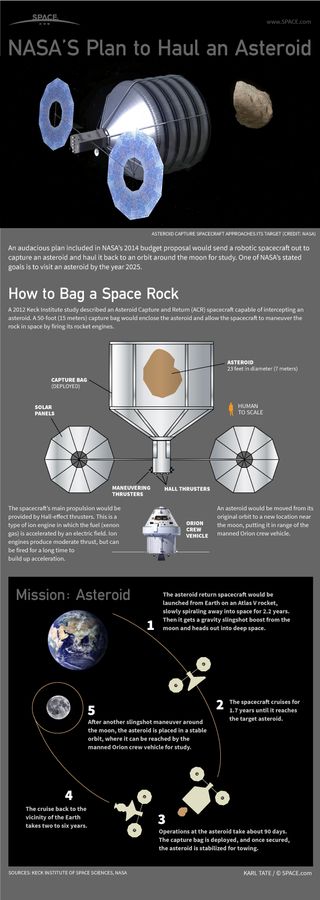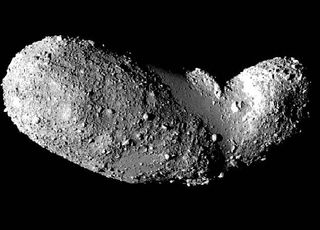
Incredible Technology: How to Grab an Asteroid and Park It Near Earth

Editor's Note: In this weekly series, Space.com explores how technology drives space exploration and discovery.
NASA's plan to lasso an asteroid, bring it into a stable orbit near the moon and let astronauts visit it might sound ambitious, but the space agency is looking at two different ways to make it happen.
In one mission, a robotic probe would fly out to a small asteroid and bring the whole thing back for astronauts to explore. The other mission involves the robot bagging a boulder from a larger space rock and parking it near the moon. Either one will help scientists work out some of technological hurdles that they could come up against while sending humans deeper into space than ever before. The new mission, first proposed in 2013, could also help researchers learn more about how to deflect a dangerous asteroid if it were on a path to Earth.

Getting to the asteroid, bringing it home and launching missions to the space rock from Earth, is no easy task, but it could serve a larger goal for NASA. By testing new technology, mission parameters and other science that hasn't yet been proved, officials with the space agency will learn more about how to accomplish the space agency's latest and greatest goal: launching astronauts to Mars. [Watch an animation of the asteroid retrieval mission]
"We really make a big deal out of this [asteroid] initiative, but you should all understand, this is a tiny, tiny piece of getting humans to Mars," NASA chief Charles Bolden said during a forum on the asteroid initiative Wednesday (March 26). "I don't want anybody to lose focus on that. The ultimate goal of this agency right now when it comes to human spaceflight is to put humans on Mars. That's hard. That is really hard. We need a proving ground to develop some of the technologies and everything else."

Snag a space rock
One idea for the asteroid retrieval mission hinges upon finding a small space rock that's relatively close to Earth and bringing it a little closer to home. For this concept, engineers would design a robot that would seal an approximately 32-foot (10 meter) near-Earth asteroid inside of a bag and deliver it into orbit near the moon.
Get the Space.com Newsletter
Breaking space news, the latest updates on rocket launches, skywatching events and more!
Asteroid 2009 BD is a valid candidate for this mission. It has a slow rotation period, meaning it is easier to target, and NASA scientists estimate that it has about 30 to 145 tons of returnable mass. Under the current mission guidelines, the robotic probe would launch in 2019 and bring the rock to the Earth-moon system in 2023, with humans launching to it by 2024 or earlier.
This version of the asteroid is expected to include "a high performance solar-electric propulsion system much larger than anything that has been flown in space up to this time, something that would be applicable and expandable to human exploration beyond LEO [low-Earth orbit] with a number of applications," Brian Muirhead, chief engineer at NASA's Jet Propulsion Laboratory in Pasadena, Calif., said during the forum.
Researchers are also looking at a few other space rocks that could be targeted, but they need to learn more about the asteroids before they can be considered valid targets. Scientists can also use this kind of mission to learn more about how to deflect an asteroid in danger of hitting Earth.

Pick a boulder, bring it home
Another concept for the asteroid-retrieval mission involves sending a robotic ship to a large asteroid, picking up a boulder on the space rock and delivering it to a stable orbit in the Earth-moon system. As with the other mission concept, astronauts would later be able to visit the asteroid when it arrives near Earth. [NASA's asteroid-capture mission in pictures]
NASA officials are looking at four large asteroids that could be target candidates for this kind of mission. Asteroid Itokawa -- a space rock previously sampled by Japan's Hayabusa mission and Asteroid Bennu, the target of NASA's Osiris-Rex sample return mission to launch in 2018 — are both on the list of possible targets. The asteroids 199 JU and 2008 EV are also on the list of candidates for a mission that would launch no earlier than June 2019.
If the first attempt to pick up a boulder on one of these larger space rocks fails, engineers will have other opportunities. The robotic probe can make a few different attempts to snag a boulder before it's necessary for the spacecraft to make its way back toward Earth.
The boulder concept would also allow NASA engineers to learn a little more about asteroid deflection. Scientists would get the chance to attempt to move the orbit of the asteroid by pushing it one way or another through a variety of procedures.
"Going to a large, near-Earth asteroid allows us to be able to do a kinetic impactor as well as these other push techniques," Dan Mazanek of NASA's Langley Research Center said.
Follow Miriam Kramer @mirikramer and Google+. Follow us @Spacedotcom, Facebookand Google+. Original article on Space.com.

Join our Space Forums to keep talking space on the latest missions, night sky and more! And if you have a news tip, correction or comment, let us know at: community@space.com.

Miriam Kramer joined Space.com as a Staff Writer in December 2012. Since then, she has floated in weightlessness on a zero-gravity flight, felt the pull of 4-Gs in a trainer aircraft and watched rockets soar into space from Florida and Virginia. She also served as Space.com's lead space entertainment reporter, and enjoys all aspects of space news, astronomy and commercial spaceflight. Miriam has also presented space stories during live interviews with Fox News and other TV and radio outlets. She originally hails from Knoxville, Tennessee where she and her family would take trips to dark spots on the outskirts of town to watch meteor showers every year. She loves to travel and one day hopes to see the northern lights in person. Miriam is currently a space reporter with Axios, writing the Axios Space newsletter. You can follow Miriam on Twitter.
